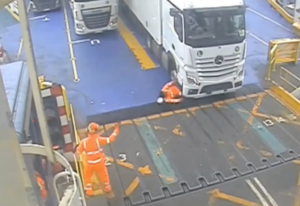The Charity
Aviation
Maritime
M2172

Initial Report
This report was submitted by the company, who are to be commended for being so willing to share this incident report to enable others to learn from their experience.
The incident involved a distressing personal near-miss incident on a RoRo cargo ferry. The crewmembers responsible for the daily task of overseeing freight movements were experienced and qualified individuals. During the incident, the reporting crewmember positioned himself in a blind spot in front of a freight vehicle. Unfortunately, he was knocked over when the freight driver misinterpreted a “thumbs-up” signal from the linkspan operator. This signal indicated that the freshwater hose had been successfully connected. However, the freight driver incorrectly interpreted this gesture as a cue to proceed with discharge. This misinterpretation occurred despite the presence of red flashing lights that were meant to signal that it was not yet safe for vehicles to move.
The incident unfolded in a generally favourable environment with mild and dry conditions, good visibility, and moderate background noise from fans and vehicle engines. Noise from fans was also audible within the driver’s cabin.
The Linkspan area was adequately staffed within the organisation with three crewmembers. A senior rating led this team, overseeing the deck and the discharge process.
The equipment used in the incident was functioning correctly. However, concerns were raised about the effectiveness of the red flashing lights as a control measure. Past instances have shown that these lights can sometimes be disregarded, indicating a weakness in their ability to influence behaviour and prevent accidents.
CHIRP Comment
Conflicting work activities were taking place when the incident occurred, and there was no common situational awareness.
The incident’s beginning lies in certain assumptions made by both the crewmembers and the freight driver. The crewmembers operated under the assumption that freight movement would only commence upon explicit instructions from the designated authority figure. Their belief in the red flashing lights being an effective safety measure to regulate freight movement created overconfidence, contributing to the incident. Additionally, they trusted that the presence of the bosun in the freight vehicle’s path would deter any untimely movement of the freight vehicle. However, the bosun, who was in the blind sector of the freight vehicle, could not be seen by the freight driver, so he did not provide any physical deterrence.
Conversely, the experienced freight driver held his assumptions. Upon seeing a thumbs-up signal from the linkspan operator (which actually confirmed the freshwater hose had been connected), the driver interpreted it as a clear directive to proceed, ignoring the red flashing lights.
The presence of the bosun in a blind spot, invisible to the driver, cancelled out the intended human barrier to prevent movement. CHIRP advocates using physical barriers instead of relying on human presence – even a coloured rope is better than nothing. CHIRP also recommends that the linkspan operators who are not ship’s staff should wear different coloured surcoats/hi-vis tabards.
Several significant takeaways emerged from this incident. It highlighted the inherent hazards linked with vehicle decks and underscored the importance of addressing blind spots. Direct eye contact with drivers emerged as a fundamental communication strategy, but one which can be mistaken by the freight drivers, emphasising the importance of unambiguous signals.
The incident also demonstrated that in the absence of a physical barrier, drivers might initiate movement at their discretion, regardless of control measures like the red flashing lights. The incident highlighted the normalisation of risk, underscoring the necessity of sustained vigilance, even for familiar and routine operations.
Ultimately, the incident serves as a reminder that even skilled crewmembers and freight drivers can face danger during routine tasks. It underscores the importance of clear and universally understood communication, particularly within hazardous environments on RoRo cargo ferries. Thankfully, the bosun did not suffer any physical injuries.
An IMCA video highlighting the risks of placing yourself in front of a hazard can be found here: Line of fire – IMCA (imca-int.com)
CHIRP strongly commends the management of the RoRo ferry for such an open and honest review of this incident report. Such incidents are rare, but CHIRP is sure that the company’s safety culture has improved, and the lives of those working on the ferries will be safer.
Key Issues relating to this report
Alerting – Everyone involved in the operation must be reminded of the hazards of movement across the linkspan. The normalisation of risk must not be allowed to become embedded. Regular training is required both for linkspan operators and freight drivers.
Local Practices – It’s vital that the company standardise theoperating practices on all their RoRo ferries..
Situational Awareness – All operators working in the linkspan environment must know they are working near hazards and potential blind spots. Before the transfer operations begin, this risk should be highlighted in the toolbox talk.
Distractions – Operating procedures must ensure that nobody is subjected to distractions, given the hazardous environment of large freight vehicles operating across the linkspan.
Fatigue – All operators working within the linkspan area must be adequately rested. Fatigue will lead to poor concentration and risk-taking if allowed to become the norm. Are your crew meeting compliance with the Hours of Work and Rest (HWR) regulations?
This data type is not supported! Please contact the author for help.






